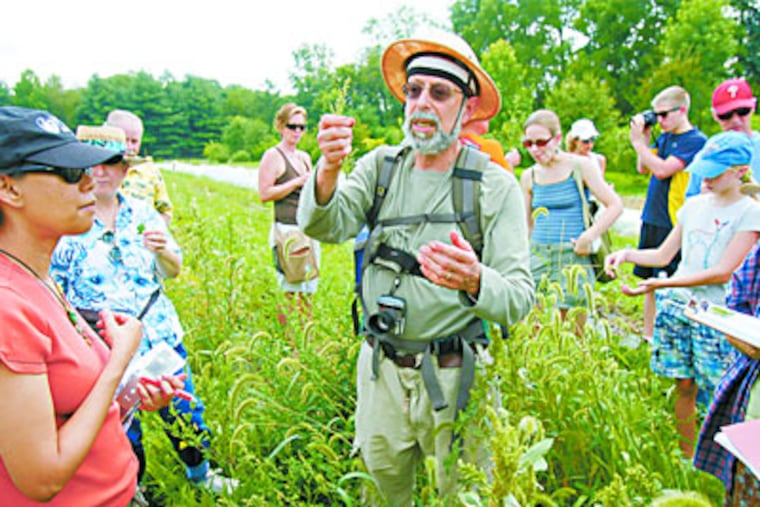GreenSpace: The 'Wildman' forages for tasty weeds
Try "nutty" amaranth, he'll urge, or vitamin-rich yellow watercress. Then he'll erupt with a wisecrack.

Steve Brill owes a good part of his success to a dandelion. That, and an irate New York parks commissioner who didn't want him eating Central Park's greenery.
It was 1986, and the now-famous forager - who roams yards and fields, eating things most people call weeds - was leading a wild foods tour in the park when two undercover agents arrested him. He was handcuffed, fingerprinted and charged with criminal mischief.
But the savvy Brill turned the arrest into opportunity. He called all the news outlets and wound up - on April 1, of all things - a topic for Dan Rather and many front pages. A sample headline: "The Man who Ate Manhattan."
After that, his career took off, not the least because the parks commissioner "turned over a new leaf," as Brill puts it, and hired him.
Now he works freelance, leading five or more tours a week. At some point he added "Wildman" to his moniker, a beard to his chin and a straw pith helmet to his head.
Last week, he made his first foraging foray into this region, leading about three dozen people on a trek around Horsham's Pennypack Farm.
It's a CSA - a subscription farm known as Community Supported Agriculture - and the irony of having Brill pluck edible weeds from between the rows of crops was nothing short of delicious.
"Our mission at the farm is to connect people to food and farming," said farm manager Fred Beddall. Since it's an organic farm - no herbicides - "we coexist with weeds."
Within the "locavore" food movement, you could hardly get more local than this. Never mind "food miles." Brill had hardly gone a few feet before he began extolling the virtues of the foxtail plant.
As he rubbed the dried plumes, tiny seeds fell into his hand and he popped them into his mouth. "Quite crunchy!"
Barely a foot away was an amaranth, whose seeds are rich in Vitamin C and have "a nice nutty flavor." He cooks them with oatmeal.
It's hard to say which he's more of - wacky or corny.
Before the walk began, he'd unloaded boxes of books, a DVD and weed identification cards for sale, calling out cheerily, "Better now than after the tour, in case you're not alive anymore."
While you can eat just about any plant once, "you can't eat all of them twice," he said, ending with a rendition of Chopin's Funeral March on the "Brillophone" - which involves clapping his hands in front of his mouth to make musical tones.
Not far away, Brill stopped to pluck some yellow watercress, "loaded with vitamins," and then wild carrot, which is "not for beginners" since it resembles poison hemlock.
The needles of the white pine can be made into a tea. Seeds of the garlic mustard can be a spicy additive to Italian dishes. The leaves of lamb's quarters make a savory substitute for spinach.
Finds of yarrow and mugwort led to a discussion of medicinal plants. Black walnut husks can be soaked in alcohol to make a tincture, "but don't use it if you are a lawyer or a politician," Brill warned. "It kills parasites."
The wisecracks came so fast and furious that one woman began punctuating them with an imitation of a wrong-answer buzzer - uhhnnnn!
Weeds, which he calls renewable resources, have been good to Brill. He met his wife on a singles foraging tour he was leading. And they named their daughter, now 5, after an edible plant: Violet.
People won't necessarily come away from one of Brill's foraging walks with enough information to gather a full meal, but they might come away with the inspiration and the notion that it's possible.
With all the time spent giving paid tours - hey, a guy's got to eat more than greens - Brill's own foraging has declined. He used to get 50 percent of his produce from the wild; now it's down to 10.
Among those on last week's walk were a youth into survival techniques, plant aficionados, and two people into raw foods, eager to discuss the industrial agricultural machine that they think is ruining the food supply, the environment, and people's health.
Brill's jokes about dying highlighted a distressing theme. Some plants are poisonous, to be sure. But how strange that we should be so seized by the dangers of the natural world and yet dismiss the health effects of all the fats, additives and chemicals in prepared foods.
Frankly, I think I'll stick with my garden and the grocery store, although I did buy Brill's book about spring greens of the Northeast. Among the 40 plants highlighted is a recipe for goutweed, which is threatening to take over my garden. I don't want to spray it, so maybe I should eat it.
Just the other morning, I spotted in my lawn the heart-shaped leaves of wood sorrel, which resembles clover.
Sparkling with dew, they looked so tempting.
So I picked a sprig. It was tender and tasted like lemon.
GreenSpace: More Information
Steve Brill's Web site is www.wildmanstevebrill.
com
The nonprofit Institute for the Study of Edible Wild Plants and Other Foragables is at www.wildfoodadventures.comEndText